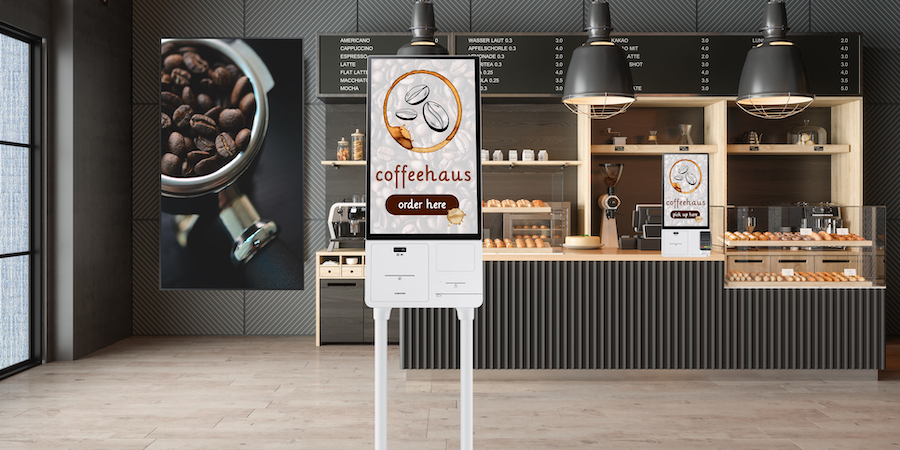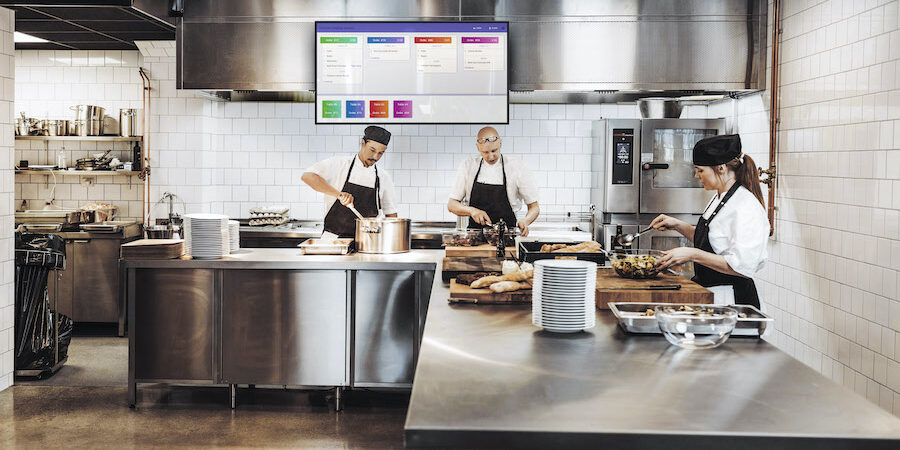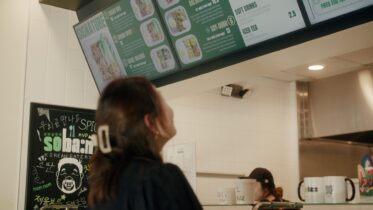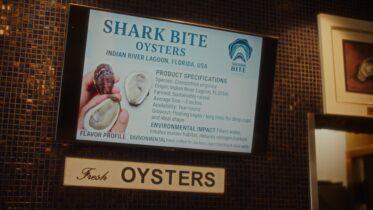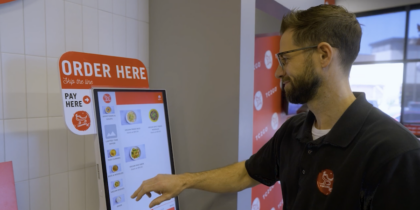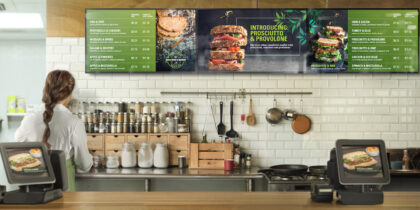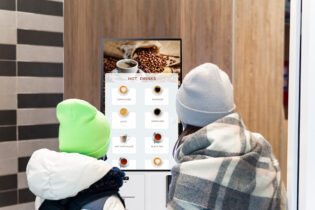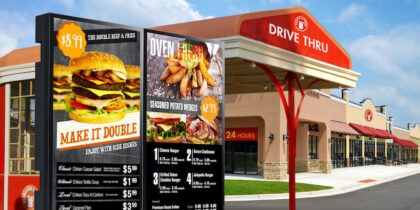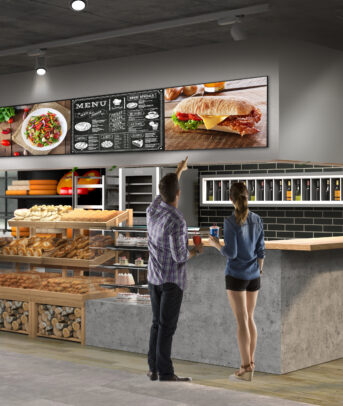Digital signage offers a powerful tool to keep customers informed and satisfied in the quick service restaurant (QSR) industry. Screens in targeted positions attract diners, display promotions and help consumers make quick and informed decisions about their meals.
The potential impact of digital signage displays has grown in the past several years, too, along with the popularity of self-service kiosks and the growth of drive-thru, delivery and curbside pickup. In fact, one report by food-service research firm Technomic showed a 30% increase in drive-thru traffic between 2019 and 2022, reinforcing how important digital signage that speaks to these customers can be to QSR owners.
Here are just some of the ways digital signage for QSRs delivers speed, convenience, satisfaction and profits.
Taking orders
Inside a typical QSR, the most prevalent use of digital signage is to display food menus behind ordering counters. Early adopters of digital menu boards liked the ability to change menus without having them printed and delivered multiple times a year, as well as the decreased on-site labor time. They also liked being able to show different menus throughout the day, especially if particular items, such as breakfast foods, were unavailable for part of each day. With a digital menu board, those changes are scheduled and automated — and can even be tied to restaurant management systems so that out-of-stock items automatically disappear from menu screens.
Self-service kiosks, such as the Samsung Windows All-In-One Kiosk, offer similar versatility — any out-of-stock food items can be automated to display a “sold out” message or be removed from the menu. Perhaps more importantly, the kiosks put customers in direct control of their orders, delivering a more personalized experience. Order accuracy is improved, too, which enhances the customer satisfaction.
Kiosks drive profit, too. One of the many key benefits of a QSR kiosk is the ability to upsell. Kiosks can suggest add-ons or bigger sizes, for example, prompting a customer to order a larger drink. In fact, research shows that kiosks and digital signage boards get people to spend 20-30% more, on average — and makes them two times more likely to order dessert. Kiosks can also inspire extra purchases by promoting limited-time offers and daily specials. If linked with a QSR’s loyalty program, it then encourages members to spend extra in return for more points or a free reward.
Easy to install and activate, the sleek, plug-and-play, all-in-one solution can be mounted on a counter, stand or wall. On top of this, Samsung Kiosks offer transactional security, remote access and mobile device management tools that allow IT and operations managers to monitor kiosks across an entire QSR network.
Streetside marketing
The rapid rise and maturity of outdoor LED displays have enabled operators to start their marketing efforts at the edges of their properties — and with significantly more ease and convenience than old-school analog signs that required someone with a long pole or a ladder to swap images or change text. For example, the fast-paced QSR Smoothie King uses an outdoor-ready multiscreen setup from Samsung to promote quick-to-prepare menu items in drive-thru lanes. This helps consumers make decisions faster, increasing throughput, sales and revenue.
Elevate your QSR by empowering employees
Explore how key technologies can help QSRs stay competitive and mitigate growing industry problems. Download Now
Direct-view LED can leverage full-color graphics and video to get motorists’ stomachs growling, and all it takes is a few keystrokes in the office to change messaging, promotions and calls to action. In fact, you can program the full day, promoting breakfast sandwiches at 7:30 a.m., lunch specials at 11 a.m., dinner bundles at 5 p.m. and snacks late at night. Digital signage also enables QSRs to quickly roll out new menus or promotions across an entire chain or at an individual location.
Restaurants are also using high-brightness LCD displays in windows to drive various messaging throughout dining days, including for curbside pickup, which can inspire additional purchases when customers arrive. Window displays are particularly useful for urban settings where pedestrians make up much of the traffic.
Quality messaging inside and out
Drive-thru lanes are highly popular for digital signage outside QSRs. High-brightness LCD displays are used to influence purchasing decisions in two key ways:
- Promotion-driven presell content on drive-thru digital signage raises awareness of new menu offers and high-margin items, like specialty coffees. Motorists see these screens as they roll toward the ordering position.
- Digital food menus on one or several clustered LCD screens show the range of ordering options, which are changeable by time of day. The screens can be programmed to highlight underperforming items or remove items from rotation as they sell out.
A relatively new, clever spin on these window-based displays — developed by Samsung — is a super-thin dual-sided LCD screen. The screen that faces the street is particularly bright, making sure it wins any battle with ambient or direct sunlight and stands out to viewers on even the sunniest days. The side facing into the store, while not as bright, will still overpower any glares from restaurant lighting.
With this setup, operators can reap the benefits of window-based marketing without forcing diners inside to look at the steel or plastic backs of a street-facing display or shade their eyes against the brightness. As an added benefit, each side can play different content on individual schedules.
Pulling it together
Most digital signage content management platforms can handle the basics like menus and promotions, but more sophisticated solutions will tie into management and payment platforms to ensure accuracy and timeliness — all while boosting sales.
For example, data-driven software can change pricing and menu items on screen the instant they change in the point of sale system. A new array of systems uses sensors and camera-based analytics to study patterns and demographics to optimize promotions down to individual consumers.
The key to QSR success will always be satisfying food and swift, friendly service, but digital signage is playing an important role in making diners aware of what’s cooking, simplifying order and pickup routines, and ensuring the process is enjoyable.
Download this free white paper for more about creating high-impact visuals indoors and outdoors with digital signage. Also find more insights on how self-service kiosks are reinventing customer service.
